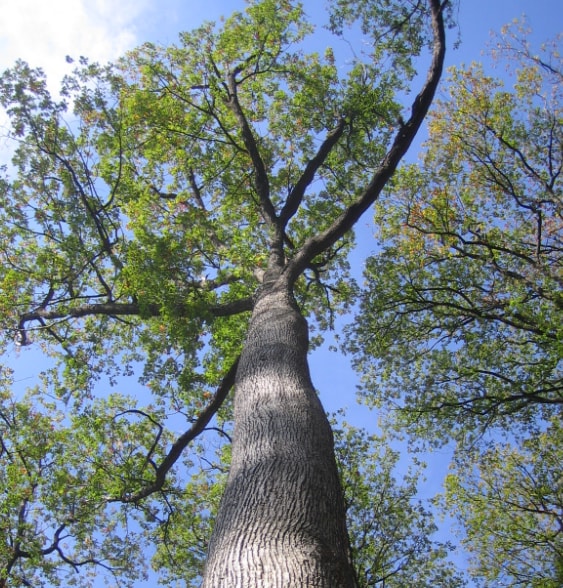 |
| Seguin Moreau photo |
Is there a difference between French and American oak, when used in wine making? That's a question asked by winemakers around the world, and it's not an easy one to answer.
When there's a new blend or varietal that might benefit from fermenting in oak or aging in oak (or both), a winemaker is confronted with the French or American question? Knowing a few constants helps the search for an answer, while making wine-buying decisions easier.
Quercus is the genus for oak, of which there are 400-500 species. Genus Quercus is divided into white oak and red oak. Only white oak is used for wine making. The species of French white oak are Quercus patraea and Quercus rubar. American white oak is Quercus alba.
White oak of the Quercus genus is chosen for wine barrels because it is watertight and the grain structure is finer than red oak. It's more complicated, but generally French oak has a tighter grain than American oak, plus the flavoring derived from French oak contact is more appealing for "seasoning" certain wines.
As a rule, French oak works well as a seasoning for both red and white wines; pink wines seldom see oak. Of course, the winemaker may have an iron-clad preference for either French or American oak, no exceptions. Finally, French oak is usually the default choice for the majority of red wines and most white wines.
American oak, though, is usually paired up mostly with red wines, like Zinfandel and the occasional Cabernet Sauvignon. American oak has an aggressiveness, when coupled with a few flavor characteristics, that make it an undesirable choice for most white wine, although there has been the odd California Chardonnay, aged in American oak.
Before we get to the specific oak types, it should be noted that the objections to American oak with white and light reds, stem from a time when U.S. coopered oak barrels used for wine, were made mainly by whiskey cooperages in non-wine producing states. The things winemakers objected to did not apply to high-proof spirits like Bourbon, but were noticeable in lower alcohol, more delicate wine.
When U.S. wineries began importing European coopered barrels, and French cooperages built facilities in California, things changed. So, let's look at the characteristics of French and American oak and how both are used today in the U.S. wine industry.
French Oak
The growing and control of oak forests in France, is closely regulated by the French government. Forest managers stipulate how many trees may be cut down and at what age. A close comparison to this sort of government regulation of a natural resource is the cork-oak forests in Portugal.
The term "French oak" covers a lot of ground. Although, today, a lot of French oak used for wine, is generally identified bois de centre, or "Central France." There are five specific forests, in an area, roughly from east of the Cognac region to the mountains west of Alsace.
The forests: Nevers, central France forest, used mainly for wine; Allier, a small area in central France, adjacent to the Nevers forest, used mainly for wine; Troncais, a small forest within Allier, used for wine; Vosges, a forest in the Vosges mountains, west of Alsace, used for wine; Limousin, near the city of Limoges, east of the Cognac region, used mainly for Cognac and brandy.
French oak has a tighter grain, and thus, gives less tannin. French oak is more dense than American oak, with vanilla, cinnamon and nutmeg nuances. These features make French oak very good for red wine and a better choice for white wine.
American Oak
American white oak is grown primarily in Missouri, Virginia, Tennessee, Arkansas and Kentucky. The forests are privately owned and not subject to government regulation, like French oak forests, although the USDA does maintain an active inventory. A large percentage of the harvested oak is used for whiskey barrels.
The characteristics that make American oak ideal for wine are similar to those of French oak, but American oak is twice as dense as French oak and the structure of American oak is more coarse, thus allowing oak tannin and flavorings to move more freely into the wine, while affecting the wine's body.
American oak delivers more spice, with dill and caramel notes and coconut, the latter an aromatic and flavoring often associated with American oak.
The Bottom Line
The original question, then, can best be answered by recognizing that there are no hard rules saying which oak should be used with which wine. The five French oaks, and American oak, are interchangeable, depending on the preferences of the user. French oak is preferred for most uses, although winemakers may choose American oak, Hungarian oak, Slovakian oak, Russian oak and more.
Ultimately, an endorsement of the winemaker's choice of either French oak or American oak, is validated when the consumer decides to buy a wine, based on taste.
Next post: Cabernets Down Under
Contact me at boydvino707@gmail.com



No comments:
Post a Comment
Note: Only a member of this blog may post a comment.